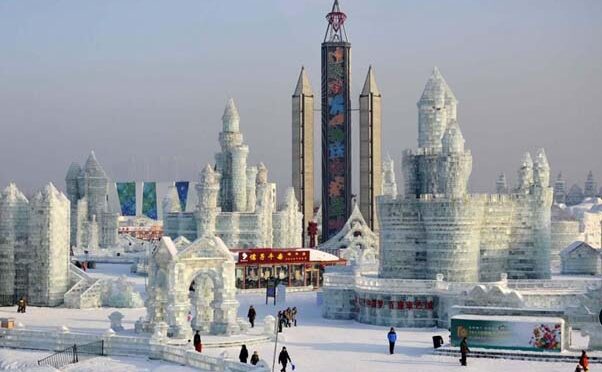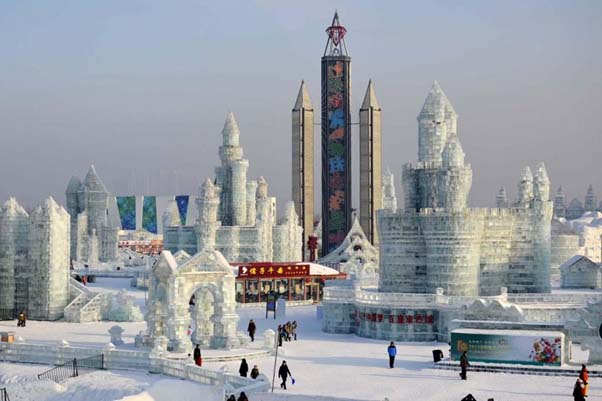Environmental Challenges in Northeast Asia and their Impact
Posted on : March 27, 2024Author : Borus Thongam

Northeast Asia, as generally defined, includes North and South Korea, Japan, Mongolia, the northeast part of China, Siberia, and the Far East part of Russia. This area covers more than 9.6 million km2 of land and comprises 318 million, or one-twentieth, of the world’s population. The end of the Cold War has softened bilateral hostilities and nurtured bilateral relations, including between China and South Korea, between China and Russia, and between Russia and its Northeast Asian neighbours.
Northeast Asia has plentiful natural resources, including minerals, energy, water, farmlands, and forests. Even more important is this area’s great mutual complementarities in terms of natural resources, labour force, and industrial structure by region. For example, Japan and South Korea, with the most dense populations and developed manufacturing industries, as well as abundant capital, technology, and information sectors, have relatively limited land area and scant natural resources. The vast and resource-rich Siberia and Far East of Russia have a sparse population and are far away from their European core. Northeastern China, with a relatively appropriate size of land area, population density and physical environment, faces a lack of resources, especially capital and technology. The uneven distribution of natural resources and industrial sectors implies a great potential for cross-border cooperation among these countries.
Northeast Asia also faces several serious environmental challenges, whose causes and effects are local, regional, and global. Three of the main challenges include dust and sand storms resulting from desertification, air pollution, and marine pollution in adjoining sea areas. Dust and sand storms (DSS, also referred to as yellow dust or Asian dust) are the major environmental concerns in the region. The main cause of DSS is the rapid expansion of desertification in China and Mongolia, due to the over-degradation of land from overgrazing by livestock, deforestation, the gathering of fuelwood, and mismanagement of water resources. In China alone, areas prone to desertification account for 34.6 per cent of the total territory. DSS have significant impacts on human health (they are linked to respiratory and skin diseases), the environment, and the economy; such storms may damage buildings and land, as well as paralyze infrastructure such as transportation hubs (in particular airports), communication networks, and power and water supply systems. Unlike dust and sand storms, fine dust, an air pollutant that was included as a Group 1 Carcinogen in 2013 by the World Health Organization (WHO), primarily originates from the combustion of fossil fuels from coal-fired thermal power plants and transportation. In particular, ultrafine dust known as PM2.5 (particulate matter with a diameter of 2.5 micrometres or less) can easily penetrate human skin and the respiratory system, thus causing respiratory, cardiovascular, and cerebrovascular diseases. According to a study conducted by the research organization Berkeley Earth in 2015, it is estimated that 17 per cent of all deaths in China are attributable to air pollution.
Northeast Asian seas comprise the Yellow Sea (including the Bohai Sea), the East China Sea, and the East Sea (also referred to as the Sea of Japan). All seas are witnessing increasing levels of marine degradation. The primary challenges faced by the seas in the region include harmful algal blooms, maritime environmental accidents such as oil spills, increasing threats to biodiversity and marine litter. It causes massive deaths of marine animals due to oxygen depletion and toxins produced. This phenomenon also represents a threat to human health through bioaccumulation of toxins in the food chain. Marine biodiversity in the region is also decreasing over time. It is estimated that 60 of 194 species are at risk of extinction because of the Invasion of alien species, overfishing, warming sea temperatures, aquaculture etc. Indeed, the fast growth of fishery and aquaculture in the region is profoundly changing the ecosystem and food chain patterns. Finally, marine litter is a significant problem in Northeast Asian seas. It is reported that between 1.32 and 3.53 million tons of plastic waste reportedly entered the ocean from China’s coastal area in 2010 – the highest of any country.
Dongbei (formerly known as Manchuria), the northeastern Chinese part along with other Northeast Asia regions such as eastern Inner Mongolia, the Russian Far East south of the Amur River, the Korean peninsula and the Japanese islands are varied in geology but connected by coastlines and much early contact was probably by boat. The Dongbei and its surroundings are more continental. Chonji, the Heavenly Lake, occupies a large crater in mountains called Changbaishan (Ever White Mountains) in Chinese and Paektusan (Whitehead Mountain) in Korean. Lower mountains separate northeastern China from the Russian Far East and eastern Inner Mongolia from the Do,ngbei. None of the mountains made impenetrable barriers. The Northeastern China, or Dongbei in Chinese, has always been unique. It is not only a region in a geographical sense, but also in a cultural sense. It consists of three provinces and the northeastern part of Inner Mongolia, and the people who live there have a strong self-identity and think of the region as a collective whole. Mao Zedong, the founding father of modern China, called the region the “eldest son” of the People’s Republic of China. In a family, the eldest son Shoulders more responsibility in securing the family’s future. And that was exactly the role of Dongbei in the development of the People’s Republic during the first three decades of its establishment.
The lives of people there in Northeastern China or Dongbei are impacted by many factors of various prevailing situations, environmental conditions, and impacts from other neighbouring countries etc. Now we can discuss about the environmental factors that assist the living conditions of people in Northeastern China, also called Manchuria in history. The Northeastern is an important breadbasket region of China, as the Northeast China Plain has the largest stretch of arable flatland in the country, with an abundance of fertile black soil. The region is, on the whole, more heavily urbanized than most parts of China, largely because it was the first part of the country to develop heavy industry owing to its abundant coal reserves. The northeastern region has long served as China’s production base for food, important raw materials, equipment manufacturing and heavy chemical industries. The rural population is heavily concentrated in the warmer southern part of the Northeast, where very warm to hot summer weather permits crops such as maize and millet to be grown with high yields. Soybeans and flax are also very important, as are wheat and barley. The region possesses large flocks of sheep, and pigs are abundant in the more densely settled southern part. The northern half of Heilongjiang is so cold and poorly drained that agriculture is almost impossible; however, the Amur River provides very rich fisheries, and sheep are even more abundant than in southern Heilongjiang.
Three provinces of Northeast China namely Heilongjiang, Liaoning and Jilin province attract tourists from all over the world. Harbin, the ice city of China’s northeast Heilongjiang province, is no doubt the hottest spot in winter, attracting visitors not just from other parts of China but also overseas. The Harbin phenomenon has even sparked a ripple effect. The city’s popularity has brought attention to the other two northeastern provinces, Jilin and Liaoning; both are also experiencing a tourism boom. The ice and snow in the Heilongjiang region have indeed turned into silver and gold through tourism motives. Today, this “Rust Belt” region of China is undergoing revitalization and has become popular with tourists. A reliable source reported that since the 2023 Ice and Snow Festival, the number of tourists and tourism revenue in Heilongjiang have increased by 332.5 per cent and 898.3 per cent, respectively. Over the New Year’s Day holiday this year, Jilin province received more than 6 million domestic tourists and collected tourism revenues of 5.3 billion yuan (US$737 million), a year-on-year increase of 406.69 per cent and 659.06 per cent respectively. Over the same holiday in Liaoning, the province received over 7 million tourists and nearly 5.2 billion yuan in revenues, a rise of 157.6 per cent and 203.8 per cent respectively. Thus the environmental conditions provide a means for the livelihoods of the people living there to a high standard.
However, those assisting environmental conditions will not always be a factor in supporting its living conditions. Due to its harsh winters, people in Northeastern China experience long, cold winters with heavy snowfall and freezing temperatures. This poses a difficulty in transportation, agriculture and overall daily life. Residents are required of heating systems, winter clothing and altered travel plans in order to adapt to its environmental conditions. Industrial activities and coal burning contribute to severe air pollution in the regions, resulting in respiratory health issues and related diseases. Therefore residents are prone to respiratory illness and reduced outdoor activities during periods of heavy pollution. It is estimated that China’s air pollutants significantly contribute to the air pollution of both South Korea and Japan. According to a 2010 report of the Long-range Transboundary Air Pollutants project, China accounts for approximately 70 per cent of atmospheric nitrogen oxides (NOx), especially during the winter season. Pollution from industrial activities and agricultural runoff can contaminate water sources, impacting drinking water quality and access to clean water for households and agriculture. Water scarcity and pollution are also significant issues in some parts of Northeastern China, Dongbei. Multiple regions in Northeastern China have raised the level of emergency response to flooding and issued meteorological warnings as some areas are facing challenges caused by intensified floods that have endangered people’s lives, homes, as well as farmland. Known as the country’s “grain barn,” Northeastern China’s Heilongjiang Province has released a disaster relief plan for flood-hit agricultural production, recently. Northeast Asia is prone to natural disasters such as earthquakes and typhoons, which can cause widespread damage to infrastructure, homes, and livelihoods. Dongbei, although less prone to typhoons, can still experience their effects indirectly, such as heavy rainfall and flooding. In Heilongjiang Province, 12 rivers have exceeded the warning level, and 26 reservoirs were operating over the limit by 0.03 to 1.95 meters last year. Heilongjiang, which accounted for 11.3 per cent of the country’s total grain output in 2022, vowed to ensure agricultural production targets through a disaster relief plan, in which it called for multiple measures, including speeding up field drainage to minimize the time of waterlogging, strengthening control of pests and diseases and farmland management and scientific prevention. Along with Heilongjiang, Northeast China’s Jilin Province has also been heavily hit by flooding which claimed the lives of 14 people last year.
Overall, the environmental conditions in Northeast Asia ( especially Northeastern China, Dongbei) have significant implications for the daily lives, health, and economic well-being of the people living in the region. Adaptation strategies and efforts to mitigate environmental challenges are essential for improving quality of life and promoting sustainable development.
References :
1.Northeast Asia in regional perspective
https://www.tandfonline.com/doi/full/10.1080/10225706.2021.1952778
2.Environmental Challenges and Corporation in Northeast Asia
https://isdp.se/publication/environmental-challenges-cooperation-northeast-asia/
3.China Northeast is finally turning ice and snow into silver and gold-some help
https://www.scmp.com/comment/opinion/article/3250574/chinas-northeast-finally-turning-ice-and-snow-silver-and-gold-some-help
4.Environmental Issues and Regimes in Northeast Asia
5.Northeast Plain, China ( also known as Dongbei Pingyuan, Manchurian Plain)
https://www.britannica.com/place/Northeast-Plain
Borus Thongam
Intern, Asia in Global Affairs
The views, thoughts, and opinions expressed in the text belong solely to the author, in his personal capacity. It does not reflect the policies and perspectives of Asia in Global Affairs.




